User:Chouji Ochiai/Sandbox
Appearance
My Sandbox!
† In danger
| Image | Site | Location | Criteria | Area (ha) |
Area (acre) |
Year | Description |
|---|---|---|---|---|---|---|---|
| File:Abu Mena, Egipto.JPG | Abu Mena† | Abusir, |
Cultural: (iv) |
182 | 450 | 1979 | The ruins of the former Christian holy city contain a church, a baptistery, basilicas, public buildings, streets, monasteries, houses, and workshops, and were built over the tomb of Menas of Alexandria.[1] The World Heritage Committee designated Abu Mena as an endangered site in 2001, due to recent cave-ins in the area caused by the clay at the surface, which becomes semi-liquid when met with "excess water".[2] |
 |
Aflaj Irrigation Systems of Oman | Dakhiliya, Sharqiya and Batinah Regions, |
Cultural: (v) |
1,456 | 3,600 | 2006 | The five aflaj of this property are representative of the approximately 3,000 such irrigation systems still used in Oman. Also known as a Qanat, aflaj systems tap aquifers through a series of vertical shafts and a gently sloping tunnel and transport it underground to agricultural or settled areas. Aflaj systems in Oman may date from as early as 2500 BC.[3] |
 |
Al Qal'a of Beni Hammad | Maadid, |
Cultural: (iii) |
150 | 370 | 1980 | The ruins of the fortified first capital of the Hammadid emirs was originally founded in 1007 and demolished in 1152. It features an 8-bay, 13-aisle mosque, and is one of the largest in Algeria.[4] |
| Al-Hijr Archaeological Site (Madâin Sâlih) | Al-`Ula, |
Cultural: (ii), (iii) |
1,621 | 4,010 | 2008 | Saudi Arabia's first World Heritage Site, the archeological site of Al-Hijr is the largest conserved site of the Nabataean civilization south of Petra in Jordan. It was an important nexus of the international caravan trade in Late Antiquity. Al-Hijr is home to the remains of monumental tombs and an intricate hydraulic system. This architectural heritage speaks to the various cultural influences that intersected here.[5] | |
 |
Amphitheatre of El Jem | El Djem, |
Cultural: (iv), (vi) |
1.37 | 3.4 | 1979 | The Amphitheatre of El Jem, built during the 3rd century, is North Africa's largest coliseum with a capacity of 35,000 spectators, and "illustrates the grandeur and extent of Imperial Rome."[6] |
 |
Ancient Ksour of Ouadane, Chinguetti, Tichitt and Oualata | Ouadane, Chinguetti, Tichitt, and Oualata, |
Cultural: (iii), (iv), (v) |
— | — | 1996 | "Founded in the 11th and 12th centuries to serve the caravans crossing the Sahara, these trading and religious centres became focal points of Islamic culture. [...] Typically, houses with patios crowd along narrow streets around a mosque with a square minaret. They illustrate a traditional way of life centred on the nomadic culture of the people of the western Sahara."[7] |
 |
Ancient Thebes with its Necropolis | Qena, |
Cultural: (i), (iii), (vi) |
7,390 | 18,300 | 1979 | The former capital of Egypt from the Middle and New Kingdoms and city of the Egyptian god Amun contains relics from the height of Ancient Egypt. The temples, palaces and the necropolises of the Valley of the Kings and the Valley of the Queens bear "a striking testimony to Egyptian civilization." [8] |
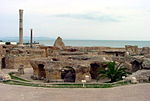 |
Archaeological Site of Carthage | Tunis, |
Cultural: (ii), (iii), (vi) |
— | — | 1979 | Founded in the 9th century BCE, Carthage was developed into a trading empire spanning the Mediterranean, and was, according to UNESCO, "home to a brilliant civilization." The city was destroyed in 146 BCE in the Punic Wars at the hands of the Romans, but was later rebuilt by these.[9] |
 |
Archaeological Site of Cyrene | Jebel Akhdar, |
Cultural: (ii), (iii), (vi) |
— | — | 1982 | The originally-Greek colony was Romanized and transformed into a capital, until it was destroyed by an earthquake in 365. The thousand-year-old ruins have remained renowned since the 18th century.[10] |
 |
Archaeological Site of Leptis Magna | Khums, |
Cultural: (i), (ii), (iii) |
— | — | 1982 | The Roman city of Leptis Magna was enlarged by Emperor Septimius Severus, who was had been born there. Public monuments, a harbour, a marketplace, storehouses, shops, and homes were among the reasons for its induction into the list.[11] |
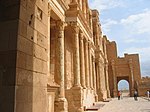 |
Archaeological Site of Sabratha | Zaouia, |
Cultural: (iii) |
— | — | 1982 | "A Phoenician trading-post that served as an outlet for the products of the African hinterland, Sabratha was part of the short-lived Numidian Kingdom of Massinissa before being Romanized and rebuilt in the 2nd and 3rd centuries [CE]."[12] |
 |
Archaeological Site of Volubilis | Meknes, |
Cultural: (ii), (iii), (iv), (vi) |
42 | 100 | 1997 | The important Roman outpost of Volubilis was founded in the 3rd century BCE to become the capital of Mauritania. It contained many buildings, the remains of which have survived extensively to this day.[13] |
 |
Ashur (Qal'at Sherqat)† | Al-Shirqat, |
Cultural: (iii), (iv) |
70 | 170 | 2003 | While this Sumerian city was founded in the 3rd millennium BC, it enjoyed the height of its power as religious and political capital of the Assyrian Empire between the 14th and 9th centuries BC.[14] The site was immediately added to the List of World Heritage in Danger upon its inscription, as a dam project nearby threatened to partially flood it.[15] |
 |
At-Turaif District in ad-Dir'iyah | Diriyah, |
Cultural: (iv), (v), (vi) |
29 | 72 | 2010 | Al-Diriyah was the first capital of the Saudi Dynasty, and is located on the northwestern outskirts of modern-day Riyadh. The monumental architecture is characteristic of the Najdi (Highland) style of the central Arabian Peninsula.[16] |
 |
Banc d'Arguin National Park | Nouadhibou and Azefal, |
Natural: (ix), (x) |
1,200,000 | 3,000,000 | 1989 | The park consists of sand dunes, coastal swamps, small islands, and shallow bodies of water, all bordering the coast of the Atlantic Ocean. Birds are often found to migrate in the area, accompanied by various species of sea turtles and dolphins, whose presence fishermen often use to attract fish.[17] |
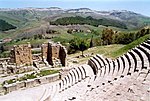 |
Djémila | Sétif, |
Cultural: (iii), (iv) |
30 | 74 | 1982 | The ruins of a Roman town in a mountainous location, including a forum, temples, basilicas, triumphal arches and houses, each adapted to a location 900 m above sea level.[18] |
 |
Dougga / Thugga | Béja Governorate, |
Cultural: (ii), (iii) |
70 | 170 | 1997 | The site features the ruins of Dougga, a former capital of a Libyan–Punic state, which flourished under Ancient Rome and the Byzantine Empire, but declined in the Islamic period.[19] |
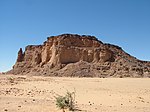 |
Gebel Barkal and the Sites of the Napatan Region | Meroë, |
Cultural: (i), (ii), (iii), (iv), (vi) |
183 | 450 | 2003 | The five sites in the Nile Valley feature temples that are a testimony to the Napatan (900–270 BCE) and Meroitic (270 BCE – 350 CE) cultures.[20] |
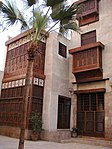 |
Historic Cairo | Cairo, |
Cultural: (i), (v), (vi) |
524 | 1,290 | 1979 | Located in the middle of urban Cairo is one of the world's oldest Islamic cities, dating from the 10th century and reaching its golden age in the 14th century. It contains mosques, madrasah, hammams and fountains.[21] |
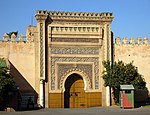 |
Historic City of Meknes | Meknes, |
Cultural: (iv) |
— | — | 1996 | The former capital was founded in the 11th century and turned into an impressive city in Spanish-Moorish style during the 17th and 18th centuries.[22] |
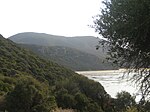 |
Ichkeul National Park | Bizerte, |
Natural: (x) |
12,600 | 31,000 | 1980 | Ichkeul Lake and the surrounding wetlands is a major stopover for hundreds of thousands of migrating bird, including ducks, geese, storks and pink flamingos. Ichkeul is the last remaining lake in a chain that once extended across North Africa.[23] |
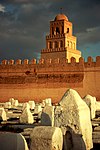 |
Kairouan | Kairouan Governorate, |
Cultural: (i), (ii), (iii), (v), (vi) |
68 | 170 | 1988 | The city was founded in 670 and flourished as a capital in the 9th century. Its heritage includes the Mosque of Uqba and the Mosque of the Three Gates.[24] |
 |
Kasbah of Algiers | Algiers, |
Cultural: (ii), (v) |
60 | 150 | 1992 | A unique Islamic city located on the Mediterranean coast, the former site overlooks the Carthaginian trading posts of the 4th century BCE. It contains remains of a citadel, old mosques and Ottoman-style palaces.[25] |
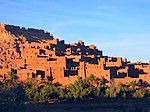 |
Ksar of Ait-Ben-Haddou | Aït Benhaddou, |
Cultural: (iv), (v) |
3.03 | 7.5 | 1987 | The ksar is a group of earthen building surrounded by high walls, a traditional pre-Saharan habitat.[26] |
 |
M'Zab Valley | Ghardaïa, |
Cultural: (ii), (iii), (v) |
4,000 | 9,900 | 1982 | The intact, traditional human habitat was built around five ksour in the 10th century by the Ibadites.[27] |
 |
Medina of Essaouira (formerly Mogador) | Essaouira, |
Cultural: (ii), (iv) |
30 | 74 | 2001 | The fortified seaport built during the late 18th century has a mix of North African and European architecture, and been a major trading hub between Sahara and Europe.[28] |
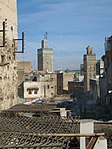 |
Medina of Fez | Fez, |
Cultural: (ii), (v) |
280 | 690 | 1981 | The former capital was founded in the 9th century and features the world's oldest university. The urban fabric and principal monuments date from the 13th and 14th centuries.[29] |
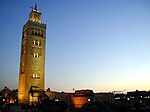 |
Medina of Marrakesh | Marrakesh, |
Cultural: (i), (ii), (iv), (v) |
1,107 | 2,740 | 1985 | The town was founded in the 1070s and remained a political, economic and cultural center for a long time. Monuments from that period include the Koutoubiya Mosque, the kasbah and the battlements. The city also has newer architectural jewels, including palaces.[30] |
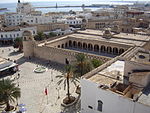 |
Medina of Sousse | Sousse Governorate, |
Cultural: (iii), (iv), (v) |
32 | 79 | 1988 | The city was an important commercial and military port during the 9th century and a typical example of a town dating from the first centuries of Islam.[31] |
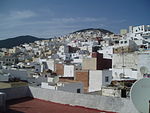 |
Medina of Tétouan (formerly known as Titawin) | Tétouan, |
Cultural: (ii), (iv), (v) |
7 | 17 | 1997 | Morocco's most complete medina served as the main point of contact between Morocco and Andalusia during the 8th century. After the reconquista, the town was rebuilt by Andalusian refugees.[32] |
 |
Medina of Tunis | Tunis, |
Cultural: (ii), (iii), (v) |
296 | 730 | 1979 | The medina contains 700 monuments, including palaces, mosques, mausoleums, madrasah and fourtains, testifying to Tunis golden age from the 12th to the 16th century.[33] |
 |
Memphis and its Necropolis – the Pyramid Fields from Giza to Dahshur | Giza, |
Cultural: (i), (iii), (vi) |
16,358 | 40,420 | 1979 | The former capital contains exceptional funerary monuments, including rock tombs, mastabas, temples and pyramids. One of the Seven Wonders of the Ancient World.[34] |
| Nubian Monuments from Abu Simbel to Philae | Aswan, |
Cultural: (i), (iii), (vi) |
374 | 920 | 1979 | Located along the Nile, the site contains monuments such as the Temple of Ramsesses II and the Sanctuary of Isis.[35] | |
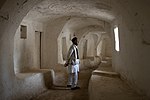 |
Old Town of Ghadamès | Ghadames, |
Cultural: (v) |
— | — | 1986 | Located in an oasis, Ghadames is one of the oldest pre-Saharan cities and represents a traditional domestic architecture with vertical division of functions.[36] |
 |
Portuguese City of Mazagan (El Jadida) | El Jadida, |
Cultural: (ii), (iv) |
8 | 20 | 2004 | The fortification was built in Renaissance military design in the early 16th century, and taken over by Morocco in 1769. Surviving Portugese buildings include the cistern and a Gothic church.[37] |
 |
Punic Town of Kerkuane and its Necropolis | Nabeul Governorate, |
Cultural: (iii) |
— | — | 1985 | The city was abandoned in 250 BCE during the First Punic War, and remains the only example of a Phoenicio–Punic settlement.[38] |
 |
Qal'at al-Bahrain | Jidhafs, |
Cultural: (ii), (iii), (iv) |
32 | 79 | 2005 | People have lived in or around the Bahrain Fort since the 24th century BC, and the successive layers of human history in the area have created the hill that it stands on: at typical tell. The site was possibly once the Dilmun civilization's capital city, and most recently it was the site of a Portuguese fort.[39] |
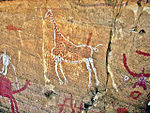 |
Rock-Art Sites of Tadrart Acacus | Fezzan, |
Cultural: (iii) |
— | — | 1985 | The rocky massif has thousands of cave paintings in very different styles, dating from 12,000 BCE to 100 CE.[40] |
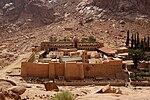 |
Saint Catherine Area | South Sinai Governorate, |
Cultural: (i), (iii), (iv), (vi) |
60,100 | 149,000 | 2002 | The orthodox monastery from the 6th century is at the foot of Mount Horeb where, according to the Old Testament, Moses received the Tablets of the Law. The area is sacred for Christians, Muslims and Jews.[41] |
 |
Tassili n'Ajjer | Illizi and Tamanrasset, |
Mixed: (i), (iii), (vii), (viii) |
7,200,000 | 18,000,000 | 1982 | A geological site in a lunar landscape with 15,000 cave arts that record climatic changes, animal migrations and evolution of human life, dating from 6000 BCE to the first centuries CE.[42] |
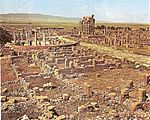 |
Timgad | Batna Province, |
Cultural: (ii), (iii), (iv) |
0.04 | 0.099 | 1982 | Created as a military colony by Emperor Trajan in 100 CE, the site features cardo and decumanus streets, typical of Roman town planning.[43] |
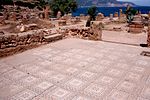 |
Tipasa | Tipaza, |
Cultural: (iii), (iv) |
52 | 130 | 1982 | First a Carthaginian trading center, Tipasa was converted into a military base by the Romans. The coastal town served as a jumping off point for the conquest of Mauritania. Heavy Christian influences can be seen from the 3rd and 4th centuries, though Tipasa went into steady decline in the Byzantine period.[44] |
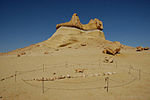 |
Wadi Al-Hitan (Whale Valley) | Faiyum Governorate, |
Natural: (viii) |
20,015 | 49,460 | 2005 | Located in a desert, the site contains fossil remains of the now extinct Archaeoceti, a suborder of whales, showing the evolution of the whales from a land-based to a aquatic mammal.[45] |
References
[edit]- ^ "Abu Mena". UNESCO. Retrieved 28 May 2010.
- ^ "Abu Mena - Threats to the Site (2001)". UNESCO. Retrieved 27 August 2010.
- ^ "Aflaj Irrigation Systems of Oman". UNESCO. Retrieved 10 January 2011.
- ^ "Al Qal'a of Beni Hammad". UNESCO. Retrieved 28 May 2010.
- ^ "Al-Hijr Archeological Site". UNESCO. Retrieved 10 January 2011.
- ^ "Amphitheatre of El Jem". UNESCO. Retrieved 28 May 2010.
- ^ "Ancient Ksour of Ouadane, Chinguetti, Tichitt and Oualata". UNESCO. Retrieved 28 May 2010.
- ^ "Ancient Thebes with its Necropolis". UNESCO. Retrieved 28 May 2010.
- ^ "Archaeological Site of Carthage". UNESCO. Retrieved 28 May 2010.
- ^ "Archaeological Site of Cyrene". UNESCO. Retrieved 28 May 2010.
- ^ "Archaeological Site of Leptis Magna". UNESCO. Retrieved 28 May 2010.
- ^ "Archaeological Site of Sabratha". UNESCO. Retrieved 28 May 2010.
- ^ "Archaeological Site of Volubilis". UNESCO. Retrieved 28 May 2010.
- ^ "Ashur (Qal'at Sherqat)". UNESCO. Retrieved 17 January 2011.
- ^ "Threats to the Site". UNESCO. Retrieved 17 January 2011.
- ^ "At-Turaif District in ad-Dir'iyah". UNESCO. Retrieved 11 January 2011.
- ^ "Banc d'Arguin National Park". UNESCO. Retrieved 28 May 2010.
- ^ "Djémila". UNESCO. Retrieved 28 May 2010.
- ^ "Dougga / Thugga". UNESCO. Retrieved 28 May 2010.
- ^ "Gebel Barkal and the Sites of the Napatan Region". UNESCO. Retrieved 28 May 2010.
- ^ "Historic Cairo". UNESCO. Retrieved 28 May 2010.
- ^ "Historic City of Meknes". UNESCO. Retrieved 28 May 2010.
- ^ "Ichkeul National Park". UNESCO. Retrieved 28 May 2010.
- ^ "Kairouan". UNESCO. Retrieved 28 May 2010.
- ^ "Kasbah of Algiers". UNESCO. Retrieved 28 May 2010.
- ^ "Ksar of Ait-Ben-Haddou". UNESCO. Retrieved 28 May 2010.
- ^ "M'Zab Valley". UNESCO. Retrieved 28 May 2010.
- ^ "Medina of Essaouira (formerly Mogador)". UNESCO. Retrieved 28 May 2010.
- ^ "Medina of Fez". UNESCO. Retrieved 28 May 2010.
- ^ "Medina of Marrakesh". UNESCO. Retrieved 28 May 2010.
- ^ "Medina of Sousse". UNESCO. Retrieved 28 May 2010.
- ^ "Medina of Tétouan (formerly known as Titawin)". UNESCO. Retrieved 28 May 2010.
- ^ "Medina of Tunis". UNESCO. Retrieved 28 May 2010.
- ^ "Memphis and its Necropolis – the Pyramid Fields from Giza to Dahshur". UNESCO. Retrieved 28 May 2010.
- ^ "Nubian Monuments from Abu Simbel to Philae". UNESCO. Retrieved 28 May 2010.
- ^ "Old Town of Ghadamès". UNESCO. Retrieved 28 May 2010.
- ^ "Portuguese City of Mazagan (El Jadida)". UNESCO. Retrieved 28 May 2010.
- ^ "Punic Town of Kerkuane and its Necropolis". UNESCO. Retrieved 28 May 2010.
- ^ "Qal'at al-Bahrain". UNESCO. Retrieved 17 January 2011.
- ^ "Rock-Art Sites of Tadrart Acacus". UNESCO. Retrieved 28 May 2010.
- ^ "Saint Catherine Area". UNESCO. Retrieved 28 May 2010.
- ^ "Tassili n'Ajjer". UNESCO. Retrieved 28 May 2010.
- ^ "Timgad". UNESCO. Retrieved 28 May 2010.
- ^ "Tipasa". UNESCO. Retrieved 11 January 2011.
- ^ "Wadi Al-Hitan (Whale Valley)". UNESCO. Retrieved 28 May 2010.
